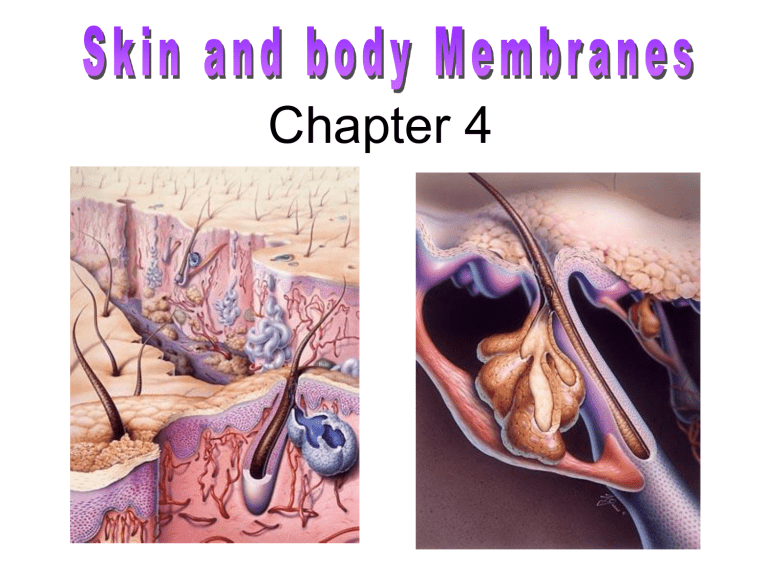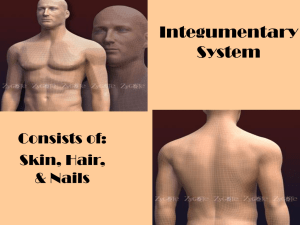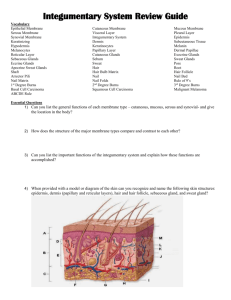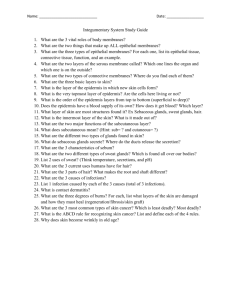
Chapter 4 Cutaneous Membrane • Cutaneous membrane = skin – Dry membrane – Outermost protective boundary • Superficial epidermis is composed of keratinized stratified squamous epithelium • Underlying dermis is mostly dense connective tissue Cutaneous membrane (skin) (a) Cutaneous membrane (the skin) covers the body surface. Figure 4.1a Connective Tissue Membrane • Synovial membrane – Connective tissue only – Lines fibrous capsules surrounding joints – Secretes a lubricating fluid Ligament Joint cavity (contains synovial fluid) Articular (hyaline) cartilage Fibrous capsule Synovial membrane Articular capsule Integumentary System • Skin (cutaneous membrane) • Skin derivatives – sweat glands, oil glands, hair & nails • Protects deeper tissue from: bumps, chemicals, bacteria, UV rays, heat/cold, dessication • Skin functions - aids in heat loss & retention, excretion of urea, synthesizes vitamin D 5 Skin Structure • Epidermis – outer layer – Keratinized, stratified squamous epithelium • Dermis - dense connective tissue – where tattoos are placed! • Subcutaneous Layer (Hypodermis) 6 Skin Structure Where do we find tattoos? Hair shaft Dermal papillae Epidermis Papillary layer Dermis Pore Appendages of skin • Eccrine sweat gland • Arrector pili muscle • Sebaceous (oil) gland • Hair follicle • Hair root Reticular layer Hypodermis (superficial fascia) Nervous structures • Sensory nerve fiber • Lamellar corpuscle • Hair follicle receptor (root hair plexus) Cutaneous vascular plexus Adipose tissue 7 Two Layers of the Dermis: • Papillary layer – Upper dermal region, uneven with fingerlike projections (papillae) – Papillae have capillary loops for nutrients & gas exchange – Contain free nerve endings (pain) & Meissner’s corpuscles (touch) – Give you your finger & foot prints • Reticular Layer •Deepest skin layer •Contains blood vessels, sweat & oil glands •Phagocytes travel the area consuming bacteria 8 Melanin • Pigment (melanin) produced by melanocytes (cells that produce melanin) • Color is yellow to brown to black • Sunlight triggers melanin production • Excessive sun: – damages the skin – makes it leathery – depresses the immune system 9 Appendages of the Skin • Sebaceous glands – exocrine glands (have ducts) – Produce oil – found everywhere except palms/soles – Most with ducts that empty into hair follicles, some onto skin. – Glands are activated at puberty – Produce sebum (oil & fragmented cells) • Keeps skin soft & moist • Keeps hair from getting brittle • Has chemicals that kill bacteria – Whitehead/blackhead = plugged sebaceous duct – Acne – active infection of sebaceous glands 10 Appendages of the Skin • Sweat glands (sudoriferous glands) – Widely distributed in skin – TWO TYPES: • Eccrine Glands – more numerous, all over body – Produce sweat (water, salts, vit. C, urea, lactic acid) – Acidic pH 4-6, to prevent bacterial growth – HELPS REGULATE BODY TEMP. • Apocrine Glands – in axillary & genital regions, larger than eccrine – Sweat plus fatty acids & proteins, bacteria consume these causing an odor – DO NOT help with temperature regulation, function not precisely understood 11 Sweat pore Sebaceous gland Eccrine gland Dermal connective tissue Sebaceous gland duct Hair in hair follicle Secretory cells (a) Photomicrograph of a sectioned sebaceous gland (14×) 12 Control of Body Temperature • Blood vessels – blood vessels in reticular layer of dermis will dilate (open up) during increased body temperatures – Heated blood near skin surface allows heat to leave the body via evaporation of sweat, face appears flushed or red – Blood vessels will constrict (close) during low body temperatures, conserving heat • Eccrine Glands – produce sweat in response to elevated body temperature 13 Skin Cancer-The most common type of cancer • Cancer – abnormal cell mass • Two types of tumors: – Benign – cells are not able to metastisize (move to new location) – Malignant – cancerous cells that can metastisize (move to new location) Risks: 1. Skin type 2. Sun exposure 3. Family history 4. Age 5. Immunological status http://science.nationalgeo graphic.com/science/heal th-and-humanbody/human-body/skinarticle/ 14 Skin Cancer Types • Basal cell carcinoma – least malignant and most common – bump with pearly edge, rarely metastisizes, surgery 15 Skin Cancer Continued • Squamous cell carcinoma – rapid growth, metastisizes to lymph nodes – Scaly, red areas forming an ulcer, common on scalp, ears, hands & lower lip – Surgery + radiation 16 Skin Cancer Continued • Malignant melanoma – cancer of melanocytes, spreads rapidly, often deadly – 5% of skin cancer is this type, often from pigmented mole Normal mole Malignant Melanoma 17 ABCD Rule –for recognizing melanoma • A = Asymmetry – sides of mole do not match • B = Border irregularity – no smooth borders • C = Color – different colors, reds, tans, black, brown • D = Diameter – larger than 6 mm • You want moles to be symmetrical, smooth borders, one color and small!! 18 Skin Homeostatic Imbalances • INFECTIONS: – Athletes foot – fungal infection, red & itchy – Boils and carbuncles – inflammation of hair follicle & sebaceous glands caused by bacteria – Cold sores – caused by herpes simplex (viral) infection, can be activated by UV rays, anxiety, fever • Infections and allergies – Contact dermatitis – Red & blistering skin reaction to an allergen – poison ivy, detergent, etc. – Psoriasis – Overproduction of skin cells, red skin w/silvery scales, may be autoimmune, genetic link 19 Skin Homeostatic Imbalances • BURNS: – Tissue damage and cell death caused by heat, electricity, UV radiation, or chemicals – Associated dangers • Body loses supply of fluids (proteins & electrolytes) • Infection • RULE OF NINES: 11 areas of the body with 9% value each, + 1% perineum •The higher the % the greater the risk of complications and death. 20 Severity of Burns • FIRST-DEGREE BURNS – partial thickness burn, epidermis damaged, red & swollen, 2-3 days to heal, “sunburn” • SECOND-DEGREE BURNS – partial thickness burn, epidermis and papillary layer burned, red with blisters – Regrowth usually occurs with little to no scarring • THIRD-DEGREE BURNS – full thickness burn, area is blackened or gray/white, no pain (nerve endings burned off) – Grafting must be done, scarring • Burns are considered critical if: over 25% of body has 2nd degree burn, over 10% has 3rd degree burns or 3rd degree burns on hands/face/feet 21 http://www.youtube.com/watch?v=eXO_Apj KPaI&safe=active (the skin gun)







